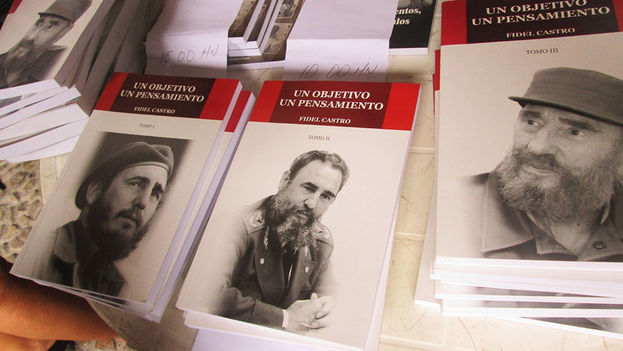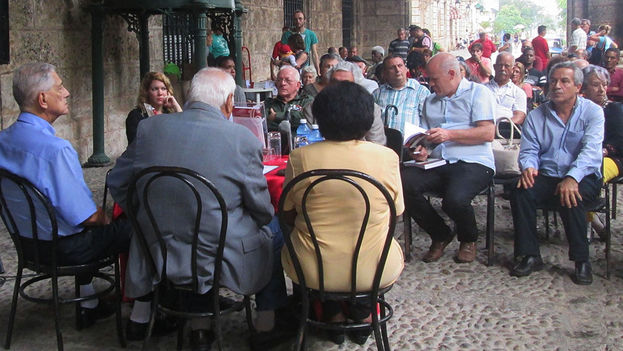
![]() 14ymedio, Reinaldo Escobar, Havana, 12 December 2016 – The first impression one gets of the book “One Objective, One Thought” is that throughout its three volumes the reader can assess the political evolution of Fidel Castro, author of the quotes contained in the tome. The initial assessment is owed to the portraits appearing on the covers of each volume, which show the physical and psychological transformation of the man.
14ymedio, Reinaldo Escobar, Havana, 12 December 2016 – The first impression one gets of the book “One Objective, One Thought” is that throughout its three volumes the reader can assess the political evolution of Fidel Castro, author of the quotes contained in the tome. The initial assessment is owed to the portraits appearing on the covers of each volume, which show the physical and psychological transformation of the man.
The first cover shows the leader with a black beard, olive green beret and defiant gaze. It is the image of the guerrilla in power during the ‘60s and ‘70s. On the second volume he is seen in the dress uniform of the Commander in Chief, notably graying and with the look of someone who has an answer for everything, as he presented himself in the ‘80s and ‘90s.
The image on the third cover reflects a moment in Castro’s life in this millennium. The former president is on the brink of old age, with a certain halo of wise experience, but maintaining his willful authority. It is a snapshot from before 31 July 20016, when he announced his retirement from public life due to the serious state of his health.
However, beyond the impression of transformation offered by these three images, the book presented this Saturday at the Palace of the Captain Generals in Havana, is simply a compilation of the ex-president’s ideas organized chronologically around 50 topics. A bundle of carefully chosen quotations to show more the continuity of his thought than its evolution.
The edition was conceived to honor the leader’s 90th birthday, celebrated this last August, but its launch has taken place a few days after his ashes were placed in a vault in Santa Ifigenia Cemetery in Santiago de Cuba. The work thought of as a summary of a life has become, in reality, a condensed post mortem of Fidel’s legacy.
The work, priced at 30 Cuban pesos (less than $1.50 US), has as an antecedent the “Dictionary of the Thinking of Fidel Castro,” prepared by Salomon Susi Sarfati for Politica Publishers in 2008. Another compilation of high value is “Thus Spake Fidel Castro,” from Roberto Bonachea Entrialgo, issued by the Spanish publisher Ediciones Idea, also in 2008.
The text was presented by Eugenio Suarez, director of the Office of Historical Affairs of the Council of State, along with the main editor of the volume, Rosa Alfonso Mestre, as a guide for action and ideas for future generations. The presentation took place in front of 50 participants, among them, notably, the faces of officials, admirers of the deceased leader and members of the Communist Party.
The editors state that “for this compilation 4,000 bibliographic sources were consulted, covering a period from October 1953 to April 2011 (…) from which around 8,000 quotes were selected.” Speeches, interviews, Fidel’s newspaper column “Reflections,” have been the principal sources.
But the reader finds a highly filtered text, which avoids quoting Castro’s mistakes, rants and more intolerant positions. For example, under the theme of terrorism, a speech he gave for the 15th anniversary of the creation of the Ministry of the Interior is omitted.

On that day in 1976, at the Karl Marx Theater in Havana, the leader admitted: “If we dedicated ourselves to terrorism, it is certain we would be effective. But the fact is that the Cuban Revolution has never used terrorism. That does not mean we renounce it, let us warn you!”
In addressing drug trafficking, the anthology does not mention a single word from Cause No. 1 of June 1989, when high officials from the armed forces were tried and condemned to death for their supposed implication in this crime.
On the subject of self-employment and private enterprise, the editors avoided the speeches given during the 1968 Revolutionary Offensive, where Castro emphasized, “We propose to eliminate all manifestations of private commerce, in a clear and decisive manner.” Three decades later, he had to once again authorize the non-state sector, to ease the profound economic crisis caused by the fall of the Soviet Union.
In the chapter dedicated to racial and gender discrimination, you cannot find a single one of the multiple occasions on which he expressed his well-known homophobia. Conspicuous by its absence are the remarks Castro delivered in March of 1963: “Many of these bums, children of the bourgeoisie, walking around with their too-tight pants; some of them with a little guitar and an ‘Elvis-Presley’ attitude have taken their debauchery to the extremes of wanting to go to some public gathering places and organize their faggot-y shows for free.”
Despite the extreme partisanship in the selection of the texts included in these three volumes, the workflow the editors faced is clear. Filtering hundreds of speeches, interminable public presentations and long hours of soliloquy must have been a marathon and exhausting task. But the most arduous work is that of the reader, peering into these pages of such a chaotic, contradictory and disproportionate legacy, like the man who created it.
